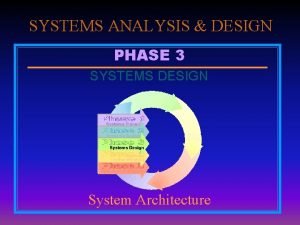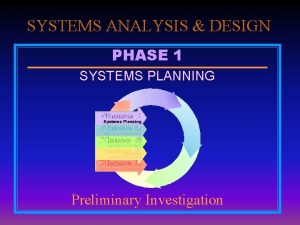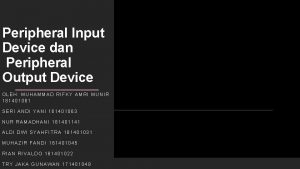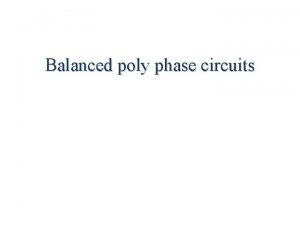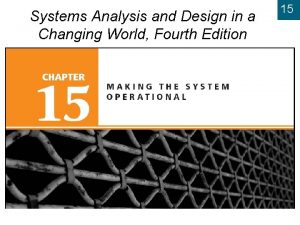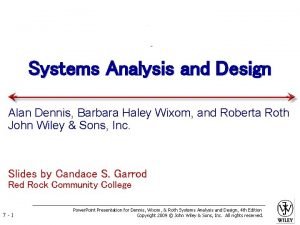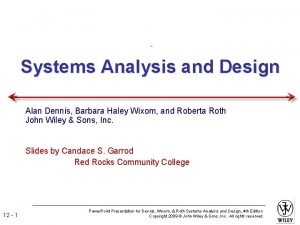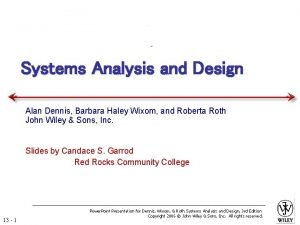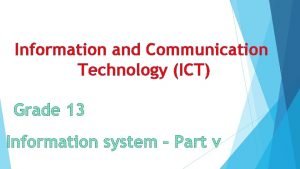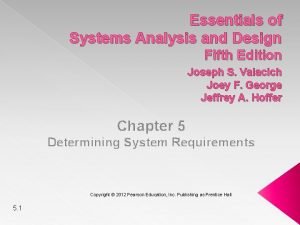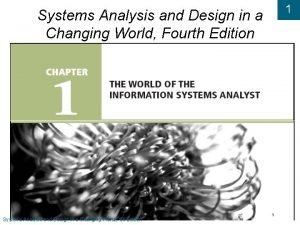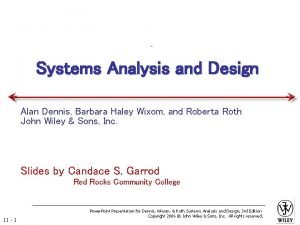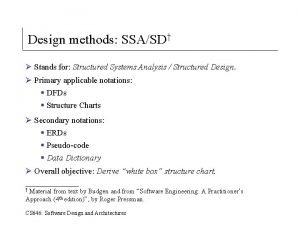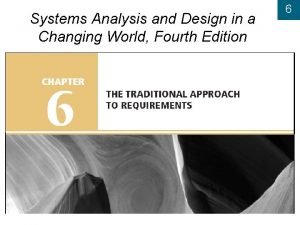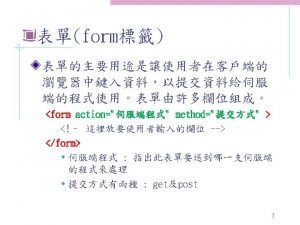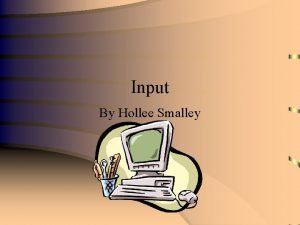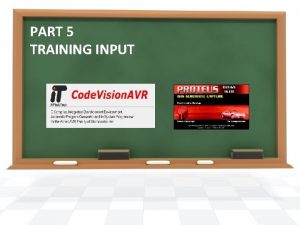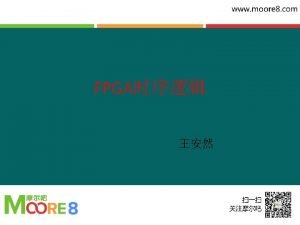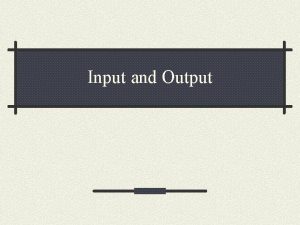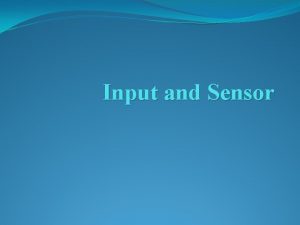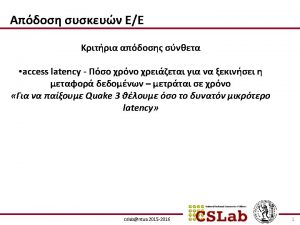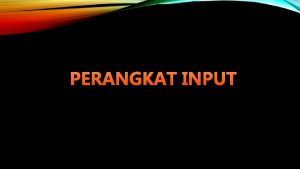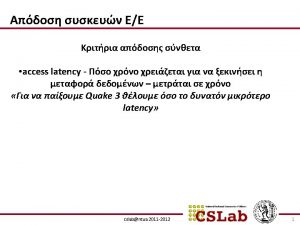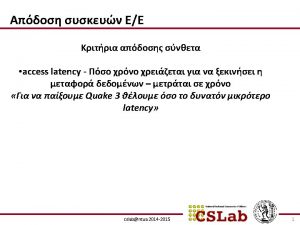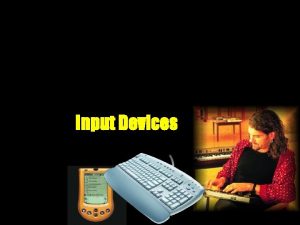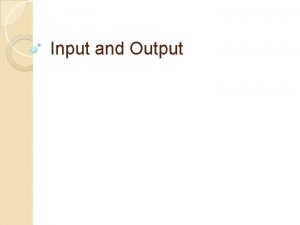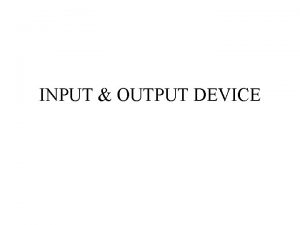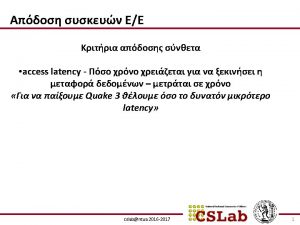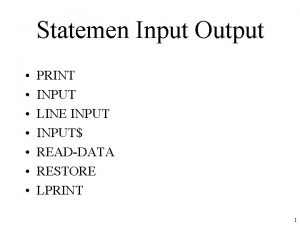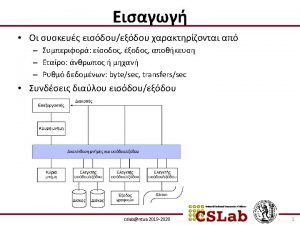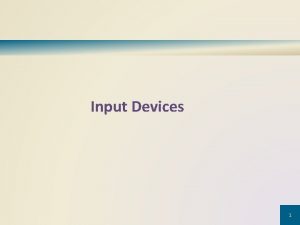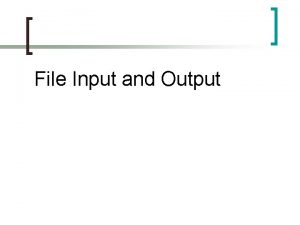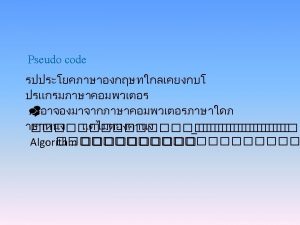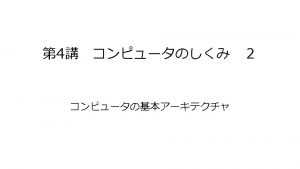SYSTEMS ANALYSIS DESIGN PHASE 3 SYSTEMS DESIGN Input




















































- Slides: 52

SYSTEMS ANALYSIS & DESIGN PHASE 3 SYSTEMS DESIGN Input Design

Chapter 7 Input Design SYSTEMS ANALYSIS & DESIGN 3 E PHASE 3 2

Objectives PHASE 3 3 à Discuss the objectives of systems input design à Explain the differences among data capture, data entry, and data input à Explain the differences between batch and online input à List and describe the different types of data validation checks à Discuss effective source document design SYSTEMS ANALYSIS & DESIGN 3 E

Objectives PHASE 3 4 à Design input records à Discuss guidelines for effective screen design à Describe and design data entry screens, process control screens, graphical user interfaces, and Help screens à Explain input control techniques SYSTEMS ANALYSIS & DESIGN 3 E

PHASE 3 5 Introduction à Input technology has changed greatly à Output quality depends on input quality à Main objectives of input design à User-friendly interface à Input processes that ensure data quality, accuracy and timeliness SYSTEMS ANALYSIS & DESIGN 3 E Click to see Figure 7 -1

Input Design Objectives PHASE 3 6 à Definitions à Data capture à Identification and recording of source data à Data entry à Conversion of source data into a computerreadable form à Data input à Process by which the computer-readable source data enters the information system SYSTEMS ANALYSIS & DESIGN 3 E

Input Design Objectives à Four main input design objectives 1. 2. 3. 4. Select input media and methods Develop efficient input procedures Reduce input volume Reduce input errors SYSTEMS ANALYSIS & DESIGN 3 E PHASE 3 7

PHASE 3 8 Input Design Objectives à Input media and data entry methods à Batch input method à Data entry is done over period of time à Collection (batch) of data is input at one time à Online data entry method à Also called direct data entry à Data is validated and available immediately SYSTEMS ANALYSIS & DESIGN 3 E Click to see Figure 7 -2

Input Design Objectives PHASE 3 9 à Input media and data input methods à Source data automation à Combines online data entry with online data capture à Uses magnetic data strips and swipe scanners à Common examples: ATMS, point-of-sale terminals, bar code readers, patient ID bracelets, libraries SYSTEMS ANALYSIS & DESIGN 3 E

Input Design Objectives à Develop efficient input procedures à Procedures à Must be efficient, timely, and logical à Must identify potential bottlenecks SYSTEMS ANALYSIS & DESIGN 3 E PHASE 3 10

PHASE 3 11 Input Design Objectives à Reduce input volume à Less volume means less time, effort, and cost à Four guidelines 1. Input necessary data only 2. Do not input data that can be retrieved from system files or calculated from other data 3. Do not input constant data 4. Use codes SYSTEMS ANALYSIS & DESIGN 3 E Click to see Figure 7 -3

TRADEOFF PHASE 3 12 à Should users ever enter retrievable data for verification purposes? à Online data entry allows immediate verification, but batch input methods do not à Batch input data can be verified by entering a second data item, such as a customer name in addition to a customer number, which must match a specific record when the data is input à Pros and cons: this method can detect invalid entries, but involves more time and expense SYSTEMS ANALYSIS & DESIGN 3 E

A KEY QUESTION PHASE 3 13 à Should Prowler Products change to an online data entry system? à Pros: improved data accuracy, customer satisfaction, and company image à Cons: more expensive à Are these valid reasons to change? à What cost-benefit issues should be analyzed? à What factors should be considered? SYSTEMS ANALYSIS & DESIGN 3 E

Input Design Objectives à Reduce input errors à Fewer errors mean better data quality à Eight types of data validation checks 1. Sequence checks 2. Existence checks 3. Data type checks 4. Range checks 5. Reasonableness checks 6. Validity checks 7. Combination checks 8. Batch controls SYSTEMS ANALYSIS & DESIGN 3 E PHASE 3 14

Key Tasks in Input Design PHASE 3 15 à Six key tasks 1. Design data entry and input procedures 2. Design source documents for data capture, or devise other data capture methods 3. Design input data records 4. Design data entry screens 5. Design user interface screens 6. Design audit trails and system security measures SYSTEMS ANALYSIS & DESIGN 3 E

PHASE 3 16 Source Document Design à Source documents à Request and collect input data à Can trigger or authorize input actions à Provide a record of the original transaction à Form layout guidelines à Allow sufficient space à Offer clear instructions à Provide logical organization à Use captions effectively SYSTEMS ANALYSIS & DESIGN 3 E Click to see Figure 7 -4

PHASE 3 17 Source Document Design à Form zones à Heading zone à Control zone à Instruction zone à Totals zone à Authorization zone à Source documents can be external or internal Click to see Figure 7 -5 Click to see Figure 7 -7 Click to see Figure 7 -6 Click to see Figure 7 -8 SYSTEMS ANALYSIS & DESIGN 3 E Click to see Figure 7 -9

PHASE 3 18 Input Record Design à Input record layout chart à To design and document batch input records à Multiple record designs are used for transactions that involve constant and repeating data à Constant fields (non-repeating data) à Repeating fields Click to see Figure 7 -10 SYSTEMS ANALYSIS & DESIGN 3 E Click to see Figure 7 -11

PHASE 3 19 Input Record Design à Information flow on a form à Should be logical and easy to follow SYSTEMS ANALYSIS & DESIGN 3 E Click to see Figure 7 -12

Input Record Design PHASE 3 20 à Information flow on a form à Should be logical and easy to follow à Poor design results in forms that are difficult to use, time-consuming, and prone to error SYSTEMS ANALYSIS & DESIGN 3 E Click to see Figure 7 -13

PHASE 3 21 Screen Design à Effective screen design guidelines 1. Screens should be attractive and uncluttered 2. Information on a single screen should be displayed in a meaningful, logical order 3. Screen designs should be consistent 4. Messages should be specific, understandable, and professional 5. Messages should remain on the screen for an appropriate period of time SYSTEMS ANALYSIS & DESIGN 3 E Click to see Figure 7 -14

PHASE 3 22 Screen Design à Effective screen design guidelines 6. Special effects should be used sparingly 7. Users should receive feedback 8. Screen designs should be documented and approved as soon as possible SYSTEMS ANALYSIS & DESIGN 3 E Click to see Figure 7 -14

Screen Design PHASE 3 23 à Data entry screen design à Guidelines 1. Restrict user access to screen locations where data is entered 2. Provide a descriptive caption for each field and show the user where to enter the data 3. Show a sample format if one is required 4. Require ending keystroke for every field 5. Do not require users to enter special characters Click to see Figure 7 -15 SYSTEMS ANALYSIS & DESIGN 3 E Click to see Figure 7 -16

Screen Design PHASE 3 24 à Guidelines 6. Do not require users to type leading zeroes or trailing spaces for alphanumeric fields 7. Do not require users to type trailing zeroes that follow a decimal point 8. Display default values that users can accept 9. Use default values for constant data 10. Display a list of acceptable values for fields with a limited number of valid choices SYSTEMS ANALYSIS & DESIGN 3 E

Screen Design PHASE 3 25 à Guidelines 11. Provide a way to leave the data entry screen without inputting the current record 12. Provide an opportunity to confirm the accuracy of input data before entering it 13. Provide a means to move among form fields in a standard, or in another, order 14. Design the screen form to match the layout of the source document SYSTEMS ANALYSIS & DESIGN 3 E Click to see Figure 7 -17

Screen Design PHASE 3 26 à Guidelines 15. Allow the operator to add, change, delete, and view records 16. Design a method to allow operators to search for a specific record SYSTEMS ANALYSIS & DESIGN 3 E

TRADEOFF PHASE 3 27 à When should input data be validated? Is it better to check the values as soon as each value is entered, or wait until all fields are input? What issues should be considered? à What type of field is involved, and does it affect other fields? à Can data be validated at time of entry? à Can missing data be obtained later? à Which method do users prefer? SYSTEMS ANALYSIS & DESIGN 3 E

A KEY QUESTION PHASE 3 28 à At Boolean Toys, should individual users be allowed to select data entry and validation methods, or should a standard method be required? à What are the pros and cons of allowing different validation methods in the same system? SYSTEMS ANALYSIS & DESIGN 3 E

PHASE 3 29 Screen Design à Process control screen design à Users can control system actions with interactive menus and prompts à Menu screens à Menus display a list of user-selectable options SYSTEMS ANALYSIS & DESIGN 3 E Click to see Figure 7 -18

PHASE 3 30 Screen Design à Process control screen design à Users can control system actions with interactive menus and prompts à Menu screens à Menus display a list of user-selectable options à Menu-driven system uses a hierarchy of main menus and submenus à Shortcut key combinations can be used in a menu design SYSTEMS ANALYSIS & DESIGN 3 E Click to see Figure 7 -19

PHASE 3 31 Screen Design à Process control screen design à Prompt screens à User types a response to a prompt SYSTEMS ANALYSIS & DESIGN 3 E Click to see Figure 7 -20

PHASE 3 32 Screen Design à Process control screen design à Prompt screens à User types a response to a prompt à Responses can include commands SYSTEMS ANALYSIS & DESIGN 3 E Click to see Figure 7 -21

PHASE 3 33 Screen Design à Process control screen design à Prompt screens à User types a response to a prompt à Responses can include commands à Structured Query Language (SQL) can be used à Question/answer screens can be used à Natural language techniques can be used, similar to Internet search engines SYSTEMS ANALYSIS & DESIGN 3 E Click to see Figure 7 -22

PHASE 3 34 Screen Design à Process control screen design à Combination screens à Menus and prompt screens can be combined effectively Click to see Figure 7 -23 a SYSTEMS ANALYSIS & DESIGN 3 E Click to see Figure 7 -23 b

Screen Design PHASE 3 35 à Graphical user interfaces à A GUI environment includes process control and data control à A GUI environment is easy to use à Common features à Menu bar à Toolbar SYSTEMS ANALYSIS & DESIGN 3 E Click to see Figure 7 -24

Screen Design PHASE 3 36 à Common features à Menu bar à Toolbar à Drop-down menus SYSTEMS ANALYSIS & DESIGN 3 E Click to see Figure 7 -25

Screen Design PHASE 3 37 à Common features à Menu bar à Toolbar à Drop-down menus à Dialog, text, and drop-down list boxes SYSTEMS ANALYSIS & DESIGN 3 E Click to see Figure 7 -26

Screen Design PHASE 3 38 à Common features à Menu bar à Toolbar à Drop-down menus à Dialog, text, and drop-down list boxes à Option (radio) buttons SYSTEMS ANALYSIS & DESIGN 3 E Click to see Figure 7 -27

Screen Design PHASE 3 39 à Common features à Menu bar à Toolbar à Drop-down menus à Dialog, text, and drop-down list boxes à Option (radio) buttons à Spin bars SYSTEMS ANALYSIS & DESIGN 3 E Click to see Figure 7 -28

PHASE 3 40 Screen Design à Help screen design à Several methods to obtain Help à Click a command button or toolbar à Press a special key à Context-sensitive Help à Provides Help on the task in progress SYSTEMS ANALYSIS & DESIGN 3 E Click to see Figure 7 -29

Screen Design PHASE 3 41 à Help screen design à Several methods to obtain Help à Click a command button or toolbar à Press a special key à Context-sensitive Help à Provides Help on the task in progress à User-selected Help à Hypertext à Uses links to display additional information on related topics SYSTEMS ANALYSIS & DESIGN 3 E Click to see Figure 7 -30

Screen Design PHASE 3 42 à Design guidelines à Provide a direct route for users to return to the program after Help is obtained à Title every Help screen à Use easy, simple, understandable Help text à Present attractive, uncluttered screens à Provide appropriate examples à Use hyperlinks à Include contact data for persons or departments responsible for assisting users SYSTEMS ANALYSIS & DESIGN 3 E

PHASE 3 43 Input Control à Measures to ensure that data is correct, complete, and secure à Effective source document design à Data validity checks à Batch input controls à Log files for rejected records à Audit trails à Data security measures, including encryption à Password and sign-on procedures à Records retention policies SYSTEMS ANALYSIS & DESIGN 3 E Click to see Figure 7 -31

Automated Design Tools PHASE 3 44 à Screen and form generators à Useful tools during input design as well as output design à Screen and form generators interact with the data dictionary à Screens and forms can include built-in field validation checks à Mock-ups can be produced quickly for user approval, together with design specifications SYSTEMS ANALYSIS & DESIGN 3 E

SOFTWEAR, LIMITED PHASE 3 45 à SWL will use the Pacific Software Solutions payroll package, and develop its own ESIP system à Rick Williams and Becky Evans will attend Pacific’s train-the-trainer workshop à Tom Adams, programmer/analyst, will work on the inputs, forms, and switchboards for the ESIP system SYSTEMS ANALYSIS & DESIGN 3 E

SOFTWEAR, LIMITED PHASE 3 46 à ESIP Option Form tasks à Design the source document SYSTEMS ANALYSIS & DESIGN 3 E Click to see Figure 7 -32

PHASE 3 47 SOFTWEAR, LIMITED à ESIP Option Form tasks à Design the source document à Design a matching data entry screen SYSTEMS ANALYSIS & DESIGN 3 E Click to see Figure 7 -33

PHASE 3 48 SOFTWEAR, LIMITED à ESIP Option Form tasks à Design the source document à Design a matching data entry screen à Create mockups à Obtain approval Click to see Figure 7 -34 a SYSTEMS ANALYSIS & DESIGN 3 E Click to see Figure 7 -34 b

PHASE 3 49 SOFTWEAR, LIMITED à ESIP Deduction Authorization Form tasks à Design the source document à Design a matching data entry screen à Create mockups à Obtain approval SYSTEMS ANALYSIS & DESIGN 3 E Click to see Figure 7 -35

PHASE 3 50 SOFTWEAR, LIMITED à ESIP Deduction Authorization Form tasks à Design the source document à Design a matching data entry screen à Create mockups à Obtain approval Click to see Figure 7 -36 Click to see Figure 7 -37 SYSTEMS ANALYSIS & DESIGN 3 E Click to see Figure 7 -38

SOFTWEAR, LIMITED PHASE 3 51 à Switchboard design à Uses command buttons, icons, and push buttons to allow users to select data entry screens and other options à Provides users with Help à Provides a way to exit from the ESIP system SYSTEMS ANALYSIS & DESIGN 3 E Click to see Figure 7 -39

SOFTWEAR, LIMITED PHASE 3 52 à Tom started by designing the ESIP Option Form, which would be a source document à Next, Tom designed a matching data entry screen à Finally, Tom created mockups and obtained approval SYSTEMS ANALYSIS & DESIGN 3 E Click to see Figure 7 -39
 Systems and forms design
Systems and forms design This is the final task in phase 3: systems design.
This is the final task in phase 3: systems design. Output of design phase
Output of design phase This is the final task in phase 3: systems design.
This is the final task in phase 3: systems design. This is the final task in phase 3 systems design
This is the final task in phase 3 systems design Normal phase vs reverse phase chromatography
Normal phase vs reverse phase chromatography Tswett pronunciation
Tswett pronunciation Mobile phase and stationary phase
Mobile phase and stationary phase Stationary and mobile phase
Stationary and mobile phase Normal phase vs reverse phase chromatography
Normal phase vs reverse phase chromatography Difference between phase voltage and line voltage
Difference between phase voltage and line voltage Chromatography mobile phase and stationary phase
Chromatography mobile phase and stationary phase In a ∆-connected source feeding a y-connected load
In a ∆-connected source feeding a y-connected load Csce 441
Csce 441 Input peripheral devices
Input peripheral devices Characteristics of natural approach
Characteristics of natural approach Solved: xco 100 pts question 8 a wye-wye four-wire system
Solved: xco 100 pts question 8 a wye-wye four-wire system Systems analysis & design in an age of options pdf
Systems analysis & design in an age of options pdf Gantt chart in system analysis and design
Gantt chart in system analysis and design Systems analysis and design in a changing world
Systems analysis and design in a changing world Systems analysis and design in a changing world
Systems analysis and design in a changing world Alan dennis system analysis design
Alan dennis system analysis design Introduction to system analysis and design
Introduction to system analysis and design Major tools of ssadm
Major tools of ssadm Case tools are limited to systems analysis.
Case tools are limited to systems analysis. Modern systems analysis and design
Modern systems analysis and design Kendall & kendall systems analysis and design
Kendall & kendall systems analysis and design Systems analysis and design alan dennis
Systems analysis and design alan dennis Systems analysis and design alan dennis
Systems analysis and design alan dennis Systems analysis and design alan dennis
Systems analysis and design alan dennis Systems analysis and design alan dennis
Systems analysis and design alan dennis Systems analysis and design alan dennis
Systems analysis and design alan dennis Systems analysis and design alan dennis
Systems analysis and design alan dennis Systems analysis and design alan dennis
Systems analysis and design alan dennis Structured systems analysis and design method
Structured systems analysis and design method Radar systems analysis and design using matlab
Radar systems analysis and design using matlab Object-oriented systems analysis and design using uml
Object-oriented systems analysis and design using uml A modern approach to systems analysis and design
A modern approach to systems analysis and design Systems analysis and design kendall
Systems analysis and design kendall Kendall kendall
Kendall kendall Systems analysis and design in a changing world
Systems analysis and design in a changing world Systems analysis and design in a changing world
Systems analysis and design in a changing world Systems analysis and design in a changing world
Systems analysis and design in a changing world Systems analysis and design alan dennis
Systems analysis and design alan dennis Systems analysis and design alan dennis
Systems analysis and design alan dennis Systems analysis and design alan dennis
Systems analysis and design alan dennis Modern systems analysis and design 7th edition
Modern systems analysis and design 7th edition Structured system analysis and design methodology
Structured system analysis and design methodology Essentials of systems analysis and design
Essentials of systems analysis and design Systems analysis and design in a changing world
Systems analysis and design in a changing world Systems analysis and design alan dennis
Systems analysis and design alan dennis Ssasd
Ssasd Systems analysis and design in a changing world
Systems analysis and design in a changing world

